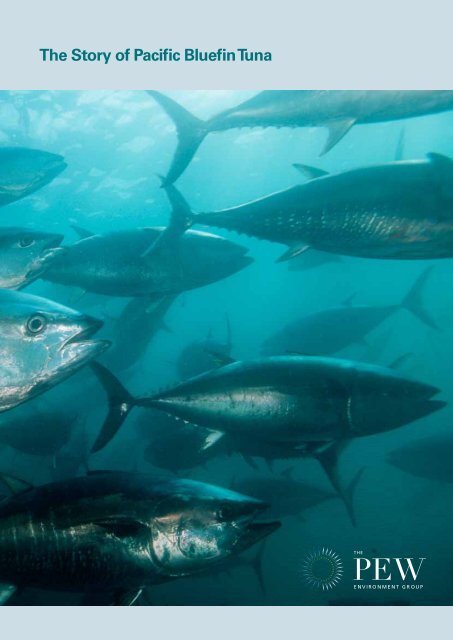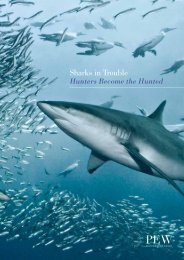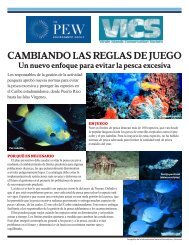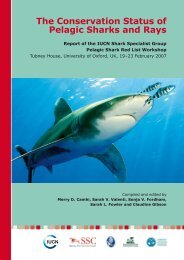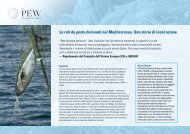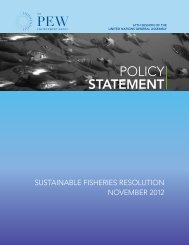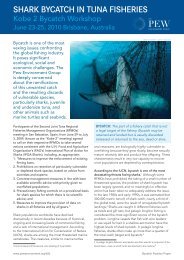The Story of Pacific Bluefin Tuna (PDF)
The Story of Pacific Bluefin Tuna (PDF)
The Story of Pacific Bluefin Tuna (PDF)
You also want an ePaper? Increase the reach of your titles
YUMPU automatically turns print PDFs into web optimized ePapers that Google loves.
<strong>The</strong> <strong>Story</strong> <strong>of</strong> <strong>Pacific</strong> <strong>Bluefin</strong> <strong>Tuna</strong><br />
<strong>The</strong> <strong>Story</strong> <strong>of</strong> <strong>Pacific</strong> <strong>Bluefin</strong> <strong>Tuna</strong>
For too long international fisheries<br />
managers have ignored <strong>Pacific</strong><br />
bluefin and now the population is<br />
severely depleted – at less than<br />
4 percent <strong>of</strong> its historical high.<br />
COVER PHOTOGRAPH: <strong>Pacific</strong> bluefin tuna, Thunnus orientalis, Mexico, <strong>Pacific</strong> (Seapics.com)<br />
<strong>The</strong> <strong>Story</strong> <strong>of</strong> <strong>Pacific</strong> <strong>Bluefin</strong> <strong>Tuna</strong>
Introduction<br />
<strong>The</strong> story <strong>of</strong> <strong>Pacific</strong> bluefin tuna is a tale <strong>of</strong><br />
extremes. <strong>The</strong>y are pursued by fishermen at every<br />
turn but largely ignored by fisheries authorities.<br />
<strong>The</strong>y migrate across the world’s largest ocean,<br />
but spawn in only three distinct areas. In parts <strong>of</strong><br />
the world, they are caught one at a time by local<br />
artisanal fishermen; but in others, entire schools<br />
are scooped up by industrial purse seine nets. <strong>The</strong><br />
<strong>Pacific</strong> bluefin is pursued at every stage <strong>of</strong> its life,<br />
from when it is a few kilogram (3 pound) juvenile to<br />
when it’s fully grown at more than 450 kilograms<br />
(1,000 pounds). A single fish commonly sells for<br />
tens <strong>of</strong> thousands <strong>of</strong> US dollars and the first fish<br />
auctioned in 2013 fetched more than 1.7 million<br />
dollars– but comparably little money goes toward<br />
research or conservation. <strong>Pacific</strong> bluefin have<br />
supported fishermen and coastal communities<br />
for thousands <strong>of</strong> years, but governments and<br />
managers have neglected this amazing fish.<br />
Now the population, at less than 4 percent <strong>of</strong><br />
its historical size, is in grave danger.<br />
While these fish weren’t even recognized as<br />
a distinct species until 1999, what little we do<br />
know about <strong>Pacific</strong> bluefin is awe-inspiring. Like<br />
their Atlantic cousins, <strong>Pacific</strong> bluefin play a very<br />
important role in their marine ecosystem as top<br />
predators, weighing up to 450 kg (1,000 pounds)<br />
and growing up to three meters (10 feet) in length.<br />
Compared to other fish species, bluefin mature<br />
slowly, which makes their populations especially<br />
vulnerable to overfishing. In the <strong>Pacific</strong>, scientists<br />
think that bluefin start reproducing between<br />
the ages <strong>of</strong> three and five years, though recent<br />
research suggests that some fish may reach<br />
maturity much later. Born in only three spawning<br />
grounds <strong>of</strong>f the coast <strong>of</strong> Japan – in the East China<br />
Sea, the Sea <strong>of</strong> Japan and in the <strong>Pacific</strong> waters<br />
<strong>of</strong>f Shikoku – many young <strong>Pacific</strong> bluefin begin a<br />
cross-oceanic migration when they are just one<br />
or two years old. While weighing only 2– 4.5 kg<br />
(five to 10 pounds), these juvenile fish make the<br />
10,000 kilometer (6,000-mile) journey to the Baja<br />
California coast in search <strong>of</strong> food in the productive<br />
waters <strong>of</strong> the eastern <strong>Pacific</strong>. After two to four<br />
years foraging <strong>of</strong>f the Mexican coast, they return<br />
home to the same western <strong>Pacific</strong> waters where<br />
they were born. Once they reach adulthood, they<br />
stay in the western <strong>Pacific</strong> for the rest <strong>of</strong> their<br />
lives, with some fish venturing further afield to<br />
southern waters <strong>of</strong>f Australia and New Zealand.<br />
Fishermen have targeted bluefin in the <strong>Pacific</strong><br />
for thousands <strong>of</strong> years, chasing a fish prized for<br />
its high-quality, deep-red meat. Historical records<br />
indicate that coastal communities in both Japan<br />
and western Canada were landing bluefin as<br />
early as 3000 BC. In Japan, small-scale fishermen<br />
took bluefin primarily by harpoon and hook and<br />
line before the use <strong>of</strong> traps and driftnets began<br />
to spread throughout the region in the latenineteenth<br />
century. At the same time, recreational<br />
fishermen <strong>of</strong>f the coast <strong>of</strong> California’s Catalina<br />
Island were targeting bluefin larger than 100 kg<br />
(220 pounds). In Mexico, the first commercial<br />
fisheries, mainly composed <strong>of</strong> purse seiners,<br />
started around 1914 and greatly expanded in the<br />
late-1950s, before declining in the 1980s and<br />
early-1990s. Also in the mid-20th century, the<br />
Japanese purse seine and longline fleets were<br />
expanding, catching bluefin on the spawning<br />
grounds and throughout the western <strong>Pacific</strong>.<br />
CHINA<br />
JAPAN<br />
Targeted<br />
by large<br />
longliners<br />
YEAR 2-3<br />
<strong>Bluefin</strong> migration route<br />
YEAR 5-7<br />
<strong>Bluefin</strong> migration route<br />
CANADA<br />
UNITED<br />
STATES<br />
<strong>Bluefin</strong><br />
spawning<br />
grounds<br />
Targeted by<br />
small boats<br />
and set nets<br />
<strong>Pacific</strong><br />
Ocean<br />
MEXICO<br />
Targeted by<br />
large purse<br />
seiners<br />
Fig. 1. <strong>The</strong> northern migration routes <strong>of</strong> <strong>Pacific</strong> bluefin tuna<br />
<strong>The</strong> <strong>Story</strong> <strong>of</strong> <strong>Pacific</strong> <strong>Bluefin</strong> <strong>Tuna</strong>
4<br />
<strong>The</strong> Rise <strong>of</strong> Ranching<br />
<strong>The</strong> most recent chapter <strong>of</strong> the <strong>Pacific</strong> bluefin<br />
story began in the mid-1990s, when increasing<br />
demand for sashimi-grade tuna in Japan led to<br />
the development <strong>of</strong> floating tuna ranches <strong>of</strong>f<br />
the coast <strong>of</strong> Mexico. Similar to the ranches in<br />
Australia and the Mediterranean, bluefin are<br />
captured, fed, fattened, and eventually killed and<br />
sent to market. This process allows ranchers to<br />
increase the fat content <strong>of</strong> the fish, producing<br />
highly desirable and pricey bluefin for the<br />
marketplace. <strong>The</strong> majority <strong>of</strong> the bluefin captured<br />
and penned in the eastern <strong>Pacific</strong> are smaller<br />
than 100 centimeters (40 inches) - these are<br />
juveniles that are three to five years old and have<br />
not yet had the chance to reproduce.<br />
<strong>The</strong> fate <strong>of</strong> the eastern <strong>Pacific</strong> fishery is strongly<br />
linked to what occurs in the waters <strong>of</strong> the<br />
western <strong>Pacific</strong>. Since these operations rely<br />
on young bluefin migrating across the <strong>Pacific</strong>,<br />
the size and success <strong>of</strong> the Mexican ranching<br />
industry is heavily dependent on the numbers<br />
<strong>of</strong> juvenile tuna that survive the fishing on the<br />
western <strong>Pacific</strong> nursery grounds and complete<br />
their journey. At one time in the early 2000’s,<br />
12 companies were permitted to run ranching<br />
operations. Now, there are only two active<br />
<strong>Pacific</strong> bluefin ranching permits in Mexico – both<br />
are owned by large, foreign companies.<br />
Japan’s Dominance<br />
Japan currently catches close to 90 percent <strong>of</strong> the<br />
bluefin taken in the western <strong>Pacific</strong>, with South<br />
Korea and Chinese Taipei accounting for much <strong>of</strong><br />
the remaining 10 percent. Japanese purse seiners<br />
target small, juvenile fish as well as adult fish on<br />
the spawning grounds, while artisanal fishermen<br />
throughout the region tend to land small fish, using<br />
a mix <strong>of</strong> handlines, trolling and set nets. Japanese<br />
and Chinese Taipei longliners catch larger fish,<br />
especially on their spawning grounds.<br />
<strong>The</strong> big fish caught by rod and reel fishermen have<br />
made headlines in recent years, as the first <strong>Pacific</strong><br />
bluefin auctioned in Japan each January sells for<br />
an astronomical price (a staggering $1.76 million<br />
dollars in 2013). Seen as a way to gain publicity and<br />
free advertising for the business that purchases<br />
it, the first fish is sold for thousands <strong>of</strong> dollars per<br />
kilogram, well above normal prices. While there is<br />
much international interest in the auction price <strong>of</strong><br />
this first <strong>Pacific</strong> bluefin, little attention is paid to the<br />
lack <strong>of</strong> regulation <strong>of</strong> both fishing and ranching, or to<br />
the bluefin’s severely depleted population.<br />
<strong>The</strong> Lack <strong>of</strong> Management<br />
<strong>The</strong> bluefin population in the <strong>Pacific</strong> is managed<br />
by two international organizations: the Western<br />
and Central <strong>Pacific</strong> Fisheries Commission<br />
Feeding time at a <strong>Pacific</strong> bluefin tuna ranch, Baja California, Mexico. (Mark Conlin / SeaPics.com)<br />
<strong>The</strong> <strong>Story</strong> <strong>of</strong> <strong>Pacific</strong> <strong>Bluefin</strong> <strong>Tuna</strong>
WESTERN PACIFIC CATCH<br />
EASTERN PACIFIC CATCH<br />
TOTAL 2011<br />
PACIFIC BLUEFIN<br />
% 81% 19% %<br />
CATCH<br />
%<br />
Japan 93%<br />
South Korea 5%<br />
Chinese Taipei 2%<br />
Mexico 83%<br />
USA 17%<br />
Fig. 2 <strong>Pacific</strong> <strong>Bluefin</strong> Catch 2011 (Source: 2012 ISC Meeting Report)<br />
(WCPFC) in the western <strong>Pacific</strong> and the Inter-<br />
American Tropical <strong>Tuna</strong> Commission (IATTC) in the<br />
eastern <strong>Pacific</strong>. Made up <strong>of</strong> representatives from<br />
the member governments that fish for tuna in<br />
the <strong>Pacific</strong>, these two bodies are responsible for<br />
managing the fisheries and reviewing scientific<br />
assessments <strong>of</strong> the species that they oversee.<br />
In the case <strong>of</strong> <strong>Pacific</strong> bluefin, however, this<br />
management and monitoring has been inadequate<br />
and has failed to protect the population from<br />
serious decline. Instead <strong>of</strong> working to manage<br />
this <strong>Pacific</strong>-wide fishery effectively, the WCPFC<br />
and IATTC have largely failed to responsibly<br />
manage the <strong>Pacific</strong> bluefin fishery.<br />
Until recently, neither the WCPFC nor the IATTC<br />
had established catch limits – or any other<br />
effective controls on the catch <strong>of</strong> <strong>Pacific</strong> bluefin.<br />
Countries fishing in the <strong>Pacific</strong> could set their<br />
own domestic regulations, but there were no<br />
overarching restrictions even though limits have<br />
existed for decades for Atlantic and southern<br />
bluefin. In 2012, for the first time, the IATTC<br />
restricted catches for the 2012–2013 fishing<br />
seasons in the eastern <strong>Pacific</strong> to 10,000 metric<br />
tons (mt), with a maximum <strong>of</strong> 5,600 mt for the<br />
2012 season. Just months after the regulation<br />
was put in place, the IATTC announced that<br />
the 2012 quota had already been exceeded by<br />
1,000 mt and the fishery was closed. While the<br />
IATTC took a critical first step in setting hard<br />
limits on the amount <strong>of</strong> <strong>Pacific</strong> bluefin that could<br />
be removed from the ocean, the limit was not<br />
science-based and its enforcement measures<br />
were not sufficient to prevent the fishermen from<br />
exceeding the quota.<br />
In the western <strong>Pacific</strong>, where bluefin are<br />
managed by the WCPFC, species-specific<br />
catch limits have never been adopted.<br />
Management <strong>of</strong> the <strong>Pacific</strong> bluefin fishery<br />
involves members self-regulating their levels<br />
<strong>of</strong> “fishing effort,” a term that is left to each<br />
member government to define individually.<br />
This has led to ineffective regulations that have<br />
failed to stop overfishing, especially <strong>of</strong> juvenile<br />
bluefin that have yet to reproduce. In fact, more<br />
than 90 percent <strong>of</strong> the <strong>Pacific</strong> bluefin caught in<br />
this area have not reached spawning age. By<br />
allowing such high numbers <strong>of</strong> these immature<br />
fish to be taken, the WCPFC is threatening the<br />
future <strong>of</strong> the population by significantly reducing<br />
its ability to recover and grow. Although current<br />
management measures were intended to<br />
prevent increases in catch, fishing mortality has<br />
actually increased by up to 41 percent over the<br />
last decade.<br />
Science Calls for Action<br />
Stock assessments for the species are<br />
conducted by the International Scientific<br />
Committee for <strong>Tuna</strong> and <strong>Tuna</strong>-like Species<br />
in the North <strong>Pacific</strong> Ocean (ISC), a small<br />
intergovernmental group <strong>of</strong> scientists that<br />
provides advice to both the WCPFC and the<br />
IATTC on <strong>Pacific</strong> bluefin. In the most recent full<br />
assessment, released in early 2013, the ISC<br />
found that the <strong>Pacific</strong> bluefin population had<br />
declined by over 96 percent from its historic<br />
levels, the population was heavily overfished,<br />
and overfishing was occurring. Catch rates <strong>of</strong><br />
the youngest bluefin, those under two years <strong>of</strong><br />
<strong>The</strong> <strong>Story</strong> <strong>of</strong> <strong>Pacific</strong> <strong>Bluefin</strong> <strong>Tuna</strong>
6<br />
age, were <strong>of</strong> particular concern, with evidence that the fishery caught nearly all <strong>of</strong> the one year<br />
old fish. <strong>The</strong> ISC noted that without further limits on catch, the population would not recover<br />
and the current amount <strong>of</strong> fishing, especially on juvenile fish, was too high and could not be<br />
considered sustainable.<br />
A Path to Recovery<br />
For too long, international fisheries managers have ignored <strong>Pacific</strong> bluefin. While<br />
WCPFC and IATTC have recently begun to implement basic management measures, the<br />
population is now at less than 4 percent <strong>of</strong> historic levels and the stock has steadily<br />
declined since 1995. Given the alarming results <strong>of</strong> the latest stock assessment, it is vital<br />
that immediate action is taken to halt the decline <strong>of</strong> this iconic species and to begin<br />
rebuilding <strong>of</strong> the population.<br />
More than 90% <strong>of</strong> the bluefin caught in the western <strong>Pacific</strong> are juveniles, and fishing continues<br />
in the spawning grounds <strong>of</strong> this heavily overfished tuna species. Catch <strong>of</strong> juvenile <strong>Pacific</strong><br />
bluefin must be reduced through strict minimum size limits, bluefin require protection on their<br />
spawning grounds, and the overall catch needs to be limited across the <strong>Pacific</strong>. Additionally,<br />
scientific knowledge needs to be increased so that future stock assessments can provide a<br />
clearer picture <strong>of</strong> the health <strong>of</strong> the <strong>Pacific</strong> bluefin population.<br />
Conclusion<br />
To reverse the decline <strong>of</strong> the bluefin population, Pew believes that the most responsible<br />
course <strong>of</strong> action is to immediately suspend the fishery until the WCPFC and the IATTC:<br />
• Set catch limits that are based on the best available science<br />
• Close the directed fishery on the spawning grounds<br />
• Implement an effective monitoring program and enforcement process<br />
• Ensure management measures are complementary and applied consistently on both<br />
sides <strong>of</strong> the <strong>Pacific</strong><br />
• Collect better data on the level <strong>of</strong> artisanal catch in Japan, South Korea and beyond<br />
• Increase the transparency <strong>of</strong> the stock assessment process<br />
• Increase scientific understanding and incorporate this new science into the stock<br />
assessment, especially regarding:<br />
o Maturation age<br />
o Triggers for bluefin migration from the northwestern <strong>Pacific</strong> to the eastern and<br />
southern <strong>Pacific</strong><br />
o Percentage <strong>of</strong> juvenile bluefin that migrate to the eastern <strong>Pacific</strong><br />
o Natural mortality<br />
o Number <strong>of</strong> young produced by each spawning adult.<br />
<strong>The</strong> <strong>Story</strong> <strong>of</strong> <strong>Pacific</strong> <strong>Bluefin</strong> <strong>Tuna</strong>
Contact: Amanda Nickson | Director <strong>of</strong> Global <strong>Tuna</strong> Conservation<br />
Pew Environment Group | international@pewtrusts.org | Tel. +1 (202)540-6528<br />
For additional resources, visit us at www.PewEnvironment.org/<strong>Tuna</strong><br />
CoNNECT:<br />
Facebook www.facebook.com/PewEnvironmentGroup<br />
Twitter www.twitter.com/PewEnvironment<br />
Philadelphia, Pa. 19103 Washington, D.C. 20004 1050 Brussels, Belgium London WC1 HBY. UK<br />
Tel. +1 (215)575-9050 Tel. +1 (202)552-2000 Tel. +32 (0)2 2741620 Tel. +44 (0)20 7388 5370<br />
<strong>The</strong> <strong>Story</strong> <strong>of</strong> <strong>Pacific</strong> <strong>Bluefin</strong> <strong>Tuna</strong>
<strong>The</strong> <strong>Story</strong> <strong>of</strong> <strong>Pacific</strong> <strong>Bluefin</strong> <strong>Tuna</strong>


